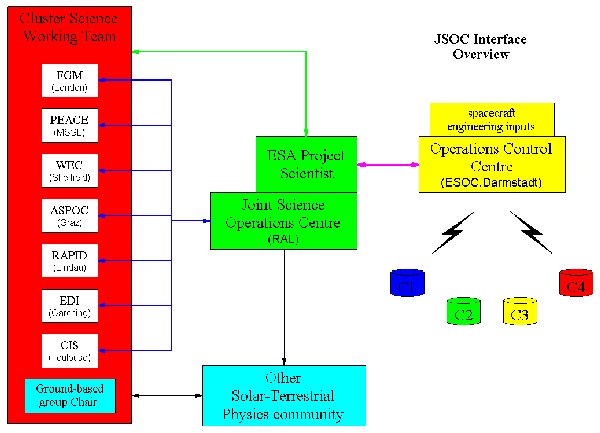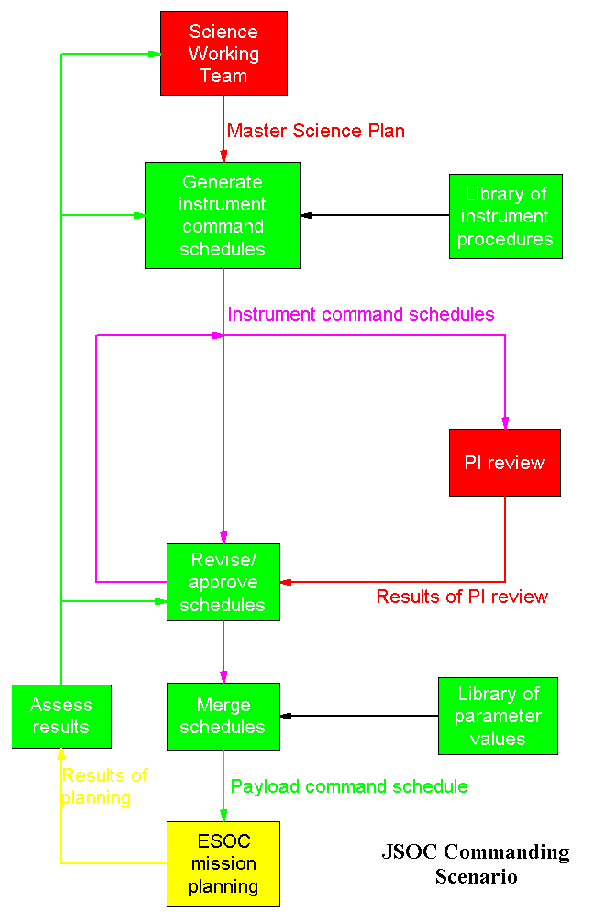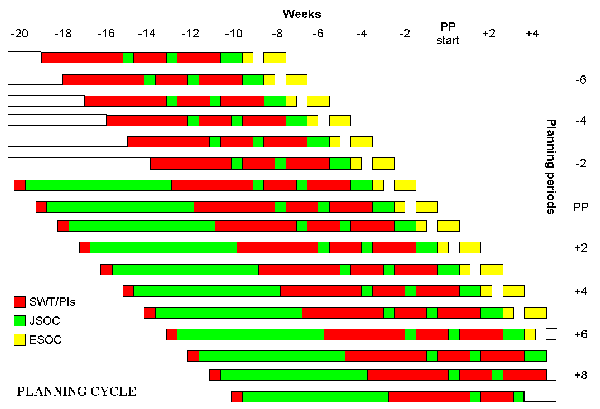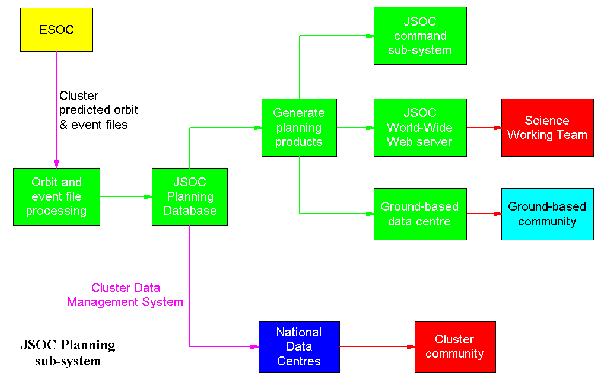Cluster-II Science Operations
Overview
JSOC's prime task is to support the coordination of Cluster-II payload
science operations by ESA's Cluster Project Scientist. This coordination
is particularly demanding for Cluster.
It is a PI-class mission, so the principal investigators for the eleven
instruments will retain a major role in instrument control throughout the
mission. (Note that this is very different from an observatory-class mission,
such as XMM, for which the major role in instrument control is delegated
to a single centre.)
The instruments on Cluster-II will measure many different properties of
the natural plasma environment in near-Earth space (magnetic and electric
fields, ions and electrons, waves). To maximise the scientific return from
the mission, the modes of the individual instruments must be coordinated
- to ensure that the different measurements are complementary.
To assist the coordination of the scientific measurements made by the different
instruments, the Cluster-II instruments can exchange data via an on-board
inter-experiment link (IEL). Thus the instrument modes must be coordinated
to ensure that an instrument receiving data via the IEL is in a mode consistent
with the mode of the instrument sending the data.
Instrument operations on the four spacecraft must also be coordinated to
ensure that data from the four spacecraft can be compared to derive the
spatial and temporal changes that are a prime science objective of the
Cluster-II mission.
JSOC will carry out this coordination under the direction of the Cluster
Project Scientist. It will be the interface through which the Principal
Investigators will submit inputs to included in the payload command schedule
and will receive feedback on the status of those inputs. To support its
work JSOC also has a number of interfaces with the Cluster-II operations
control centre at ESOC, which is responsible for overall spacecraft operations.
These JSOC interfaces are illustrated in the figure below.

Some History
JSOC was orginally prepared and validated for the Cluster-I mission.
The JSOC system was formally initialised ready for science operations on
3 June 1996 and thus was fully operational at the time of the ill-fated
launch of Cluster-I on 4 June 1996.
The JSOC system for Cluster-II is essentially the same system as was
developed for Cluster-I. Some changes have been made: (a) to accommodate
changes in the overall mission (different ground stations, different phase
of the solar cycle), (b) to install upgrades of proprietary software used
in the JSOC system (e.g. the Solaris operating system, the Oracle database)
and (c) to make a few changes that will improve operational efficiency.
Pre-launch phase
The pre-launch phase which commenced in autumn 1998 and runs up to launch.
During this phase:
the existing Master Science Plan (MSP) for the first and second constellations
will be revised and extended as necessary for Cluster-II. (The MSP is the
overall science plan that specifies the timeline of data gathering periods
on the four spacecraft and the telemetry rates to be used during those
periods -a graphical representation of the plan is available as a Bryant
plot. Constellations are periods of roughly six months between major manoeuvres
which alter the inter-spacecraft separation.)
the plan for the
inter-experiment interference campaign will be reviewed
and completed. This week-long campaign is a vital scientific objective.
It will check for interactions between the different instruments and especially
for effects of any of the active instruments (ASPOC, EDI, WHISPER) on any
other instruments. This is vital to the interpretation of data from the
Cluster-II payload.
the JSOC command database will be revised to incorporate agreed changes
in instrument operation. JSOC has preserved its database from Cluster-I
but this must be reviewed by PIs and JSOC to identify the changes needed
for Cluster-II (e.g. removal of Cluster-I patches now incorporated in on-board
software, etc.)
the JSOC-PI interfaces will be re-confirmed as part of ESA's end-to-end
test of all Cluster-II systems. This test includes preparation of an instrument
command schedule by JSOC, its execution during ground testing of one of
the spacecraft, the collection of telemetry during that test and the processing
of that telemetry by the Cluster-II ground segment. Thus it will check
all interfaces in the Cluster-II systems.
a complete command simulation exercise is performed to (re-)train PI, JSOC
and ESOC staff in the operation of the commanding system. This exercise
will be similar to the commanding system tests carried out for Cluster-I,
which proved to be valuable training exercises for all parties. But, for
Cluster-II, the primary objective will be training and not testing.
various items of PI software will be re-delivered to JSOC and the appropriate
acceptance tests will be re-executed. This software will be run by JSOC
as part of its monitoring task. It will allow JSOC to monitor the inter-calibration
between similar quantities measured on different instruments and different
spacecraft - and thus to give early warning of any problems that could
affect the quality of Cluster-II data products. This inter-calibration
is a major issue for all space plasma missions but is absolutely vital
for the comparison of data between the four Cluster-II spacecraft. JSOC
will also run some PI software to carry out specific monitoring tasks requested
by individual PIs. Re-delivery of the software will allow JSOC and PIs
to confirm the version of software used by JSOC.
Commissioning Phase
This phase begins after all four spacecraft reach the
operational orbit and runs for about three months. During this phase
there will be two
JSOC commissioning periods. These are the first periods
for which JSOC will assemble a real (but simplified) command schedule.
For the first of these periods JSOC will command FGM on a single spacecraft
for a few hours and for the second JSOC will command FGM, PEACE, RAPID
and WEC (list tbc) on two spacecraft for two (tbc) orbits. These periods
will demonstrate payload operation via a JSOC-prepared command schedule
and thus act to commission JSOC for full operations.
Execution of the
inter-experiment interference campaign. This campaign
is scheduled to take place at the end of the commissioning phase. It requires
the closely coordinated operation of all Cluster-II instruments. JSOC will
prepare the command schedule for this period using a detailed plan drawn
up in collaboration with a number of campaign coordinators
Further inter-experiment interference campaigns are likely to take place
during mission operations. JSOC will prepare these by re-using the orginal
campaign input as supplemented by additional inputs from the PIs and the
campaign coordinators.
Mission Operations Phase
This phase begins immediately after the commissioning phase
and is scheduled to continue for at least two years. It is divided into
planning periods each of which covers three orbits of the spacecraft
(= 3 x 57 = 171 hours, or just over a week).
During this phase
JSOC will generate the payload command schedule for each planning period as
shown in the figure below.
JSOC will generate a draft command schedule for each instrument (based
on the instrument modes specified in the Master Science Plan) and iterate
this with the responsible PI.
JSOC will then merge the instrument command schedules to produce the payload
command schedule and deliver this to ESOC.
ESOC will process the payload command schedule and report the results
to JSOC. JSOC will assess these results and, if necessary, make any
required changes to the command schedules.

The first draft of the instrument command schedules will be released
to the PIs eight weeks before execution on the spacecraft.
The PIs will then revise that draft so that JSOC can merge the instrument
command schedules to produce a first draft of the payload command schedule
and deliver this
to ESOC six weeks before execution on the spacecraft.
The PIs can then request JSOC to make further changes in the command
schedule (e.g. to take account of problems reported by ESOC).
This revision must be complete approximately two weeks before execution on
the spacecraft, so that JSOC can deliver the final version of the
payload command schedule to ESOC.
This final delivery has a deadline at 12:00 UTC on the Tuesday preceding
the week (Monday
to Sunday) in which the planning period starts.
As a result of this system, JSOC will,
at any one time, be preparing the payload command schedules for up
to eight planning periods.
This is illustrated in the figure below.

JSOC will also generate a number of products to support
the planning of Cluster science operations. These include the positions of the
four spacecraft - both in geometric terms (GSE x, y and z) and in magnetic
terms (magnetic local time, McIlwain L value, magnetic field strength B).
They also include the predicted times and locations (GSE x, y and z,
magnetic local time, GSM latitude) of various scientific events, e.g.
magnetopause and bow shock crossings, neutral sheet crossings, auroral zone
and L-shell crossings. The scientific events are predicted for all four
spacecraft and for the centroid of the operational spacecraft.
These products are made directly available to a number of important users:
(i) JSOC is itself a user as the events data are used in its commanding
sub-system,
(ii) they are disseminated to the Science Working Team via this webserver,
and
(iii) planning data for co-ordination of Cluster observations with
ground-based STP instruments is supplied to the Cluster Ground-based
data centre.
In addition, selected planning products are also disseminated to the wider
Cluster community via the Cluster
Data Management System as CDF-formatted files.


Last updated by Mike
Hapgood ( M.Hapgood@rl.ac.uk),
18 December 1999
|